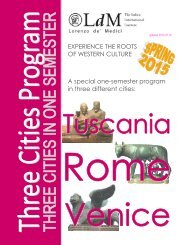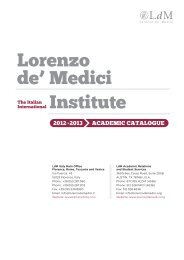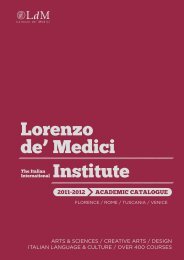aCademiC Catalog 2013-2014 - Lorenzo de Medici
aCademiC Catalog 2013-2014 - Lorenzo de Medici
aCademiC Catalog 2013-2014 - Lorenzo de Medici
Create successful ePaper yourself
Turn your PDF publications into a flip-book with our unique Google optimized e-Paper software.
and new virtual places (blogs, chat rooms, social networks,<br />
online shops, peer-to-peer platforms), shaped around our<br />
wants, though often perceived/imposed as “needs.” Following<br />
a two-step program, the stu<strong>de</strong>nt will learn about causes and<br />
effects of the digital revolution: first analyzing features and<br />
functions of all main digital communication <strong>de</strong>vices (and<br />
places), then discussing their influence on us as citizens, artists,<br />
professionals, individuals.<br />
Introduction to Journalism<br />
COM 185 F; Dual listed: WRI 185 F<br />
Cr: 3; Contact hrs: 45<br />
Journalism covers a huge range of output across all media<br />
and is an influential form of communication in almost every<br />
country of the world. Journalism involves the sifting and<br />
editing of information and events; it is about putting i<strong>de</strong>as<br />
and controversies into context, and it is about the assessment<br />
of the validity and truthfulness of actions or comments. This<br />
course will offer an introduction to the history and practical<br />
skills of print and broadcast journalism. Stu<strong>de</strong>nts will be gui<strong>de</strong>d<br />
in researching and interviewing techniques and in writing news<br />
articles, reviews and features for a variety of media. They will<br />
also have hands-on experience in preparing, recording and<br />
editing a radio program or webcast.<br />
Introduction to Visual Semiotics<br />
COM 192 F; Dual listed: GRA 192 F<br />
Cr: 3; Contact hrs: 45<br />
This course examines the problems associated with perception,<br />
un<strong>de</strong>rstanding, interpretation and creation of visual<br />
representations. In other words, it explores how it is possible to<br />
improve the way we perceive and un<strong>de</strong>rstand all the messages<br />
that we receive constantly, messages based mostly upon visual<br />
patterns. Signs and their meaning, the construction of reality,<br />
co<strong>de</strong>s and codification, mythology and i<strong>de</strong>ology, semiotics of<br />
art and mass media will be the topics raised by this course.<br />
The course inclu<strong>de</strong>s an introduction to the language of<br />
representation, through the analysis and comprehension of<br />
concepts such as rhetoric, narrative, stereotype and genre.<br />
Advertising Principles<br />
COM 204 F<br />
Cr: 3; Contact hrs: 45<br />
Advertising is not a simple or random combination of images in<br />
an ad. The task of advertising is to build a positive perception<br />
of the product in the consumer’s mind. Every commercial,<br />
every ad in magazines, every TV advertisement is <strong>de</strong>signed<br />
to <strong>de</strong>liver a particular message to a particular audience. This<br />
course will <strong>de</strong>al with contemporary advertising and also with<br />
the media and graphic mo<strong>de</strong>s used to convey it. Topics inclu<strong>de</strong><br />
the philosophy of advertising and its role in society; how<br />
advertising relates to life, society and economy; current trends<br />
in advertising as viewed from the creative, marketing and<br />
media standpoints; the stereotypes that advertising proposes<br />
to us and the reaction of our society to these suggestions; how<br />
advertising is ma<strong>de</strong>, created and projected.<br />
Prerequisites: COM 180 Mass Communication, or BUS 150<br />
Introduction to Marketing, or equivalents<br />
the working path coherent with individual expectations and<br />
capacities.<br />
Event Planning<br />
COM 232 F; Dual listed: BUS 232 F<br />
Cr: 3; Contact hrs: 45<br />
This course introduces stu<strong>de</strong>nts to special event planning<br />
processes and techniques. Emphasis is on creating, organizing,<br />
i<strong>de</strong>ntifying sponsors for, marketing and implementing largescale<br />
community events, as well as show rooms and tra<strong>de</strong><br />
shows to photoshoots and fashion shows. We will explore this<br />
very <strong>de</strong>tail-oriented field as it <strong>de</strong>als with vendors, contracts,<br />
fundraising, budgeting, ethics, and other aspects. Stu<strong>de</strong>nts<br />
will research product, competition and target market to<br />
<strong>de</strong>termine best possible exposure and success. As part of the<br />
course stu<strong>de</strong>nts may organize a real event in interdisciplinary<br />
collaboration with other <strong>de</strong>partments (Graphic Design, Jewelry<br />
Design, Photography and/or Interior Design).<br />
Media Ethics<br />
COM 245 F<br />
Cr: 3; Contact hrs: 45<br />
Today’s communications are so complex and the problems<br />
they encounter happen so sud<strong>de</strong>nly that we may not have time<br />
to consi<strong>de</strong>r all of the ethical implications. Journalists, editors,<br />
professionals in advertising and public relations are called upon<br />
to weigh up potential benefits and harm by their actions in<br />
covering stories, in revealing facts that might otherwise be kept<br />
private, and in respecting conflicting loyalties. They also find<br />
themselves confronted by situations in which they must choose<br />
between actions that seem equally right, or equally wrong.<br />
Wartime and peacetime propaganda, the Western world’s<br />
information system, the PR industry, digital convergence and<br />
new frontiers for mass communication: everyone encounters<br />
ethical dilemmas. The goal of this course is to train you to face<br />
what you will inevitably face in your professional careers and in<br />
your private lives.<br />
Integrated Marketing Communication<br />
COM 262 F; Dual listed: BUS 262 F<br />
Cr: 3; Contact hrs: 45<br />
Marketing communication is one of the most exciting and<br />
stimulating areas in mo<strong>de</strong>rn marketing. Its importance has<br />
grown dramatically in the recent <strong>de</strong>ca<strong>de</strong>s. The means through<br />
which we communicate all around the world have been<br />
affected by the new technological advances. These advances,<br />
such as the Internet, have enabled and eased interaction on a<br />
global scale. Therefore, marketers are looking for new means of<br />
communication that can better gain the attention of customers.<br />
This course will examine the theory and techniques applicable<br />
today to all the major marketing communication functions: ads,<br />
direct marketing, sales promotion, public relations, personal<br />
selling and the Internet. It will allow stu<strong>de</strong>nts to research and<br />
evaluate a company’s marketing and promotional situation and<br />
use this information in <strong>de</strong>veloping effective communication<br />
strategies and programs.<br />
Prerequisites: BUS 150 Introduction to Marketing, or equivalent.<br />
Recommen<strong>de</strong>d: COM 180 Mass Communication, or equivalent<br />
School of Arts & Sciences FLORENCE<br />
Body Language and Communication<br />
Techniques<br />
COM 212 F; Dual listed: PER 212 F<br />
Cr: 3; Contact hrs: 45<br />
This course teaches stu<strong>de</strong>nts to use the body to achieve greater<br />
professional and social success by increasing the relational and<br />
communication capacities of every stu<strong>de</strong>nt, preparing them<br />
to enter the working world. The training is aimed at acquiring<br />
transversal expertise linked to communication, verbal and non<br />
verbal, working in groups, motivation, and body language<br />
control. The “learning by doing” methodology is very practical<br />
and involves the stu<strong>de</strong>nt in a pro-active way, through exercises<br />
and improvisation, testing individual attitu<strong>de</strong>s and personal<br />
capacities. Neutral mask and participative and creative<br />
techniques will be employed, from a theatrical approach to non<br />
verbal communication, team building, self-presentation, body<br />
language exercises, movement, and motivation, guiding each<br />
stu<strong>de</strong>nt to discover his or her strengths, and to better i<strong>de</strong>ntify<br />
Crosscultural Communication in the<br />
Workplace<br />
COM 271 F; Dual listed: BUS 270 F<br />
Cr: 3; Contact hrs: 45<br />
People from more than one culture increasingly have to work<br />
together, work si<strong>de</strong> by si<strong>de</strong>, or collaborate on international<br />
projects, both at home and abroad. How easy is it to step<br />
outsi<strong>de</strong> our own cultural expectations? This is an intercultural<br />
communication course aimed specifically at un<strong>de</strong>rstanding<br />
intercultural interactions in business or in the workplace from<br />
both theoretical and practical standpoints. On a practical<br />
level, this course will involve the stu<strong>de</strong>nts’ active participation<br />
in role play exercises and observations, and will help them to<br />
predict and manage intercultural misun<strong>de</strong>rstandings both in<br />
the workplace and in more informal social settings. Business<br />
practices in different countries, in particular Italy and the USA,<br />
and individual case studies will be assessed and discussed<br />
according to these frameworks.<br />
LdM Aca<strong>de</strong>mic <strong>Catalog</strong> <strong>2013</strong>-<strong>2014</strong><br />
59





